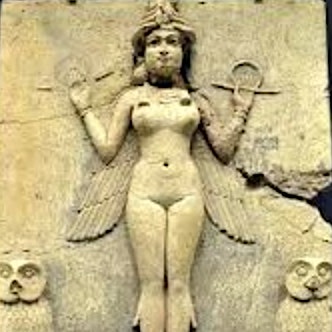
Inanna
The goddess Inanna is regarded as a warrior goddess, with influence in far more than winning battles. Described as 'greater than the gods,' she was the only deity in the pantheon who accommodated opposites and reflected both light and dark, terror and love, and destructiveness and creativity. Sumerian pantheons revered and worshiped her as a goddess of great power in her role as that of a goddess of war and that of a goddess of the varied domains of love from the love for a child to the erotic love for a partner.
In her iconography, Inanna is shown with lions/lionesses at her feet, symbolizing the unrestrained power she possesses. She clutches the Sumerian symbols of fertility, abundance, and prosperity in her hands.
Inanna, unconstrained by societal norms and expectations, epitomizes a realm beyond conventional notions of right and wrong. Her role is to lead us in acknowledging the potential within ourselves to be both immensely virtuous and intensely vile, asserting that the capacity for evil is not external, but resides within us. She embodies a harmonious confluence of elements: both the delightful, beautiful, kind, loving, uplifting, and bright, as well as the painful, repugnant, harsh, cruel, demeaning, and dark. She exists between blessing and curse, light and dark, plenty and want, goodness and malevolence, life and death. She embodies the "Real" that every living being must encounter.
We are warrior goddesses also, reflecting shadows and fractures, helping people find healing and wholeness through connection with all parts of themselves.
_ The credit for much of this bio goes to — Betty De Shong Meador, Inanna: the Queen of Heaven and Earth